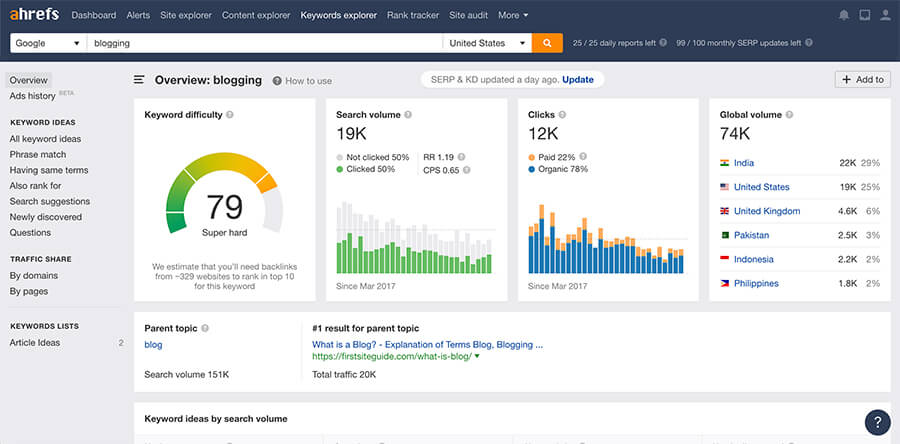When it comes to writing a blog post that not only drives in new readers but also captivates their imaginations and leaves them craving more—you’ve got to start with a blog post outline to organize your thoughts, decide what’s critical to include and make certain you’re not missing any opportunities.
I’m an adamant believer in always starting my writing process with a strong blog post outline to kick things off. Tools can help here too though, be sure to try out my forever free blog outline generator.
How to Write a Blog Post Outline in 8 Easy Steps (Free Blog Post Outline Template)
- Determine the Key Takeaways for Your Readers
- Craft a Smart Headline
- Brain Dump: Write Down Every Question You Need to Answer
- Arrange the Major Themes and Sections of Your Blog Post Outline
- Ask More Questions (Research, Research, Research)
- Insert Relevant Studies, Data and Additional Sources
- Revise, Trim and Clean Up Your Blog Post Outline
- Write Your Blog Post
Disclosure: Please note that some of the links below are affiliate links and at no additional cost to you, I’ll earn a commission. Know that I only recommend products and services I’ve personally used and stand behind. When you use one of my affiliate links, the company compensates me, which helps me run this blog and keep all of my in-depth content free of charge for readers (like you).
If you want to grab my free blog post outline template (in the form of a copy & paste Google Doc), then you can pick it up right here—which includes my entire writing checklist and a fully completed blog post outline template to guide you along the way—get my free blog post template.
Want My Free Blog Post Outline Template?
Grab my free blog post template to write better content today.
Why should you create a blog post outline before you start writing?
Allow me to paint you the picture of an all too familiar scene… You’re sitting down at your computer, just recently started your blog and you’re feeling excited to write an article on a topic you have strong feelings about.
The only problem is, the more you think about it, the more your thoughts get a little jumbled as one idea inspires another and you begin losing track of the last point you were just exploring.
Before too long, you don’t really know where to start anymore—and maybe you even forgot a point or two you initially wanted to cover. I experienced this frustration first-hand in my early blogging days before I took to starting with a blog post outline.
Here’s the thing… you know you want your content to be captivating, valuable, and relatable to your readers. But how do you make sure you’re fully getting your message across?
There are two big mistakes that many bloggers tend to make when it comes to their writing:
- The content lacks direction and is difficult to follow. Many bloggers don’t write easy-to-follow blog headlines, they struggle to make a point, they jump around in too many directions or they lose their reader’s attention by taking too long to get to the meat of the post.
- The writing lacks meaningful substance. While many bloggers do have a strong conviction on the topic they’re writing about—many don’t convey any useful information or teach their readers a beneficial new skill (like building their blogging skills).
Learning how to write a blog post outline can solve both of these challenges.
Your blog posts should be logical and cohesive if you hope to satisfy the needs of your target audience. A blog post outline can help you avoid meandering or disjointed writing—and will help organize your thoughts and make it easy for readers to digest (and take action on).
The other thing an outline will do is help you determine the real value of your blog post. Instead of sitting down and staring at a blank screen to start writing your blog post—you’ll instead take the time to research and create something unique that you know will be useful to your future readers. It’ll also show you what can be easily left out from this particular post (or better left for another day).
Now, we’re going to walk through my 8-step process to outline a blog post—using a real, working blog post outline to illustrate exactly how to do this along the way.
And remember, if you want to pick up my free blog post outline template to follow along, then head over here right now.
1. Determine the Key Takeaway for Your Readers

When you get an idea for a blog post, a great first step is to determine your number one takeaway for readers.
What do you want your readers to learn or to remember once they’ve finished reading?
This is also a good time to think about what type of blog post you’re best served to write here.
The variety in types of blog posts you can use to accomplish your goal is pretty extensive today—and each of these blog post formats has slightly different functions.
Here are the most common types of blog posts:
- How-to articles and tutorials (like my guide about how to make money blogging and how to write an eBook)
- Lists or listicles (like my 32 ways to drive traffic to your blog)
- Checklists (like my checklist of reasons why you should blog or not)
- Reviews (like my reviews of the best web hosting plans, top monthly hosting plans, and honest Bluehost reviews)
- Comparison posts (like my ConvertKit vs AWeber vs Mailchimp email tool comparison)
- Infographics (like my infographic about how to start a blog)
- Interviews (like on my podcast)
- Deep research long-form blog posts (like my deep dive into picking a niche to blog about)
- Roundup posts (like my list of top business books, books about blogging, and podcast hosting platforms)
- Current events or news (like my recent blogging statistics research)
- Controversial statements (like my just say no time management piece)
- Expert advice (like my business advice roundup)
While there are arguably many other types of blog post formats you can use, these are the most popular.
Choosing the format of your post will help you narrow down what your big takeaway is.
For example, if you’re writing a review post, you’re letting your readers know if a product or service is worth their time and money.
Readers looking at reviews are often ready (or getting ready) to spend some money and they want your honest opinion so that they can make an informed decision.
On the other hand, a how-to guide should take a step-by-step process that a reader can easily follow.
At the end of your post, they should have a framework for how to accomplish something on their own.
Let’s say I’m writing an article about the benefits of blogging for businesses.
My key takeaway for readers would be: Blogging is good for business and here’s how to do it.
The format I’d choose to create this article would be a long-form, how-to guide with some expert advice weaved in.
Now that I’ve determined the key takeaway of the piece, I’ll use the entire article to build a case and back that up.
We’ll take this idea through each step of the outlining process so that you can see how this article morphs into a fully-baked blog post outline that can fuel the rest of your writing process.
2. Craft a Smart Headline

Once you’ve determined the key takeaway of your article—and the content format you’ll best be able to communicate that—the next step in the blog post outlining process is to write a headline that’ll draw readers into reading your piece.
The headline tells readers what your blog post is about, and it’s the first thing they’ll see in a Google search result.
Headlines can make a big difference in whether or not someone clicks on your blog post. And just as there are different types of blog posts, there is also a wide variety of headlines you can use.
Need Catchy Blog Title Ideas?
Try my free AI-Powered Blog Title Generator Tool to get dozens of SEO-friendly headline ideas to make your blog posts stand out today.
Here are some of the most popular types of blog post headlines:
- The Ultimate Headline: This is the type of headline that claims to be the best resource on the Internet. Example: The Ultimate Guide to Fly Fishing
- The List Headline: This is an extremely common headline because people respond well to it. Example: 45 Blogging Statistics You Need to Know (to Blog Smarter)
- The Predictive Headline: This headline is often used in tech or business-related fields. Example: The Future of the Side Hustle: Why You Need One Today
- The Clickbait Headline: This is the type of headline that may be a little shocking, strange, or controversial in order to increase the click-through rate. It can also be downright silly if that’s your goal. Example: You Won’t Believe What Happened to This Grandma at the Grocery Store
- The Backed by Science Headline: A science-backed headline establishes authority right at the beginning. Example: Why Scientists Say Playing Video Games Can Inspire Learning
- The Best of Headline: These are often roundup blog posts that pull together all of the top products, services, advice or people in a particular field. Example: 54 Best Blogging Tools for Better Marketing, SEO, Writing and Growth
- The Big Secret Headline: This is the kind of headline that makes it clear you’re letting your readers in on something that’s little-known, exclusive, or secretive. Example: 5 Things No One Tells You About Traveling Abroad
- The How-To Headline: The How-to headline is instructive. It’s usually used to communicate that you’re teaching readers how to make or do something specific. Example: How to Start a Food Blog This Year
- The Learn What I Did Wrong Headline: You could use this headline when you’re helping other people skip the trial and error period that you had to go through yourself. Example: 10 Mistakes I Made Learning How to Surf and How to Avoid Them
The possibilities for headlines are nearly endless, but this is a great starting point to focus your outlining on.
Truth be told—I often revise my article headlines several times along the way to publishing, so you don’t need to be dead set on your headline at this stage.
While you do want to write a headline that’s catchy, clever, and interesting, you also have to keep in mind that it should be SEO-friendly.
Personally, I don’t like to use clickbait headlines for my blog content.
For one thing, they lead to a higher bounce rate (when readers arrive and are quickly disappointed or feel tricked), which is bad for your site’s organic Google rankings.
Another reason I don’t use clickbait headlines is that they often don’t include your main target keyword phrase.
That’s a major missed opportunity when it comes to SEO and bringing readers to your blog from search engines.
It goes without saying that before you can write your full article… you should do proper keyword research to know what keyword phrase you’re hoping your content will eventually rank for. So if you haven’t done that yet, now’s the time.
In my clickbait example above, my headline was… You Won’t Believe What Happened to This Grandma at the Grocery Store.
That headline might get some clicks on social media, but it’s not likely that anyone is going to be searching for it on Google.
So instead of only choosing something people will click on, you should also choose a headline that includes phrases people are actively searching for online—which dramatically increases the potential target audience you can reach.
For the blog post outline example we’re using about blogging for businesses, I might title the article something like:
- Blogging for Business: 5 Incredible Benefits of Business Blogging
- How a Blog Can Drives More Sales to Your Business
- 5 Proven Ways to Generate More Sales with a Blog for Your Business
- The Ultimate Guide to Blogging for Small Businesses in 2025
- 25 Blogging Experts Share Their Best Advice to Small Business Blogging
Which one I choose to go with in the end, will depend a lot upon the exact keyword phrase I decide on using—and a final look back at how the article shaped up.
Assuming my main target keyword phrase is “blogging for business” though… I’d likely choose the first headline.
3. Brain Dump: Write Down Every Question You Need to Answer
The next step in the process of creating your blog post outline (after you have your key takeaway and headline), is to begin writing down every question you can think of answering—that addresses your key takeaway.

Keep in mind, that you don’t necessarily need to have all of those answers yourself already, but getting your most important (original) thoughts down onto the screen right away is an important step in learning how to write faster (and better) content for your blog.
While you should be focused on creating blog content you have unique expertise at teaching to your readers, it’s natural that you’ll also have to do some of your own research or refresh on some aspects of a particular problem or subject matter.
Plus, spending time regularly reading in your field is the only way to keep improving over time.
Now, let’s get tactical on how to translate this into real output when you outline a blog post.
Using the example we’re walking through for this blog post outline, some of the questions I suspect my readers will have (as related to blogging for businesses) would include:
- How does a blog benefit a business?
- Is blogging practical for businesses?
- How can a blog help a business rank higher in a search engine result?
- How can blogging help with branding?
- How can a business use a blog to drive sales?
- Why is a blog beneficial to potential customers?
- How can a blog build a network?
- How can a blog improve communication with customers?
- How much might a blog cost a business?
- Will we make more money with a blog?
Once you’ve collected your list of questions, start prioritizing which questions are most important—and strive to narrow it down to just the most impactful ones that need to be covered in your article.
Don’t ditch the rest of those questions though—you’ll want to save them for future content topics to tackle.
And while you might not use all the questions you jot down right now, don’t worry about limiting this activity.
The goal here is to come up with every possible question a reader could have on the topic at hand.
4. Arrange the Major Themes and Sections of Your Blog Post Outline

Your content should have a natural progression that flows logically from one point to the next and educates along the way.
This is one of the strongest reasons to write a blog post outline. Without this step, it’s easy for your writing to go off the rails or lack a level of cohesiveness that your readers are going to crave in a well-constructed article.
Consider the basic essay structure most of us are taught in school—you have an opening paragraph, supporting paragraphs, and a conclusion.
Writing a blog post that successfully argues a point is pretty much the same thing.
It isn’t overly complicated, but it does take some time to fully organize, and this next step in the outlining process is crucial.
Sticking with our example of blogging for businesses, here’s how I’d start organizing my blog post outline based on prioritization and filtering of the questions I’ve determined we need to answer in this article:
Blogging for Business: 5 Incredible Benefits
- Blogging Helps Your Business Website Rank Higher in Search Engine Results
- Organic traffic is important (being present where customers are searching)
- Long-form, quality content = higher rankings in search engines
- Blogging Helps Your Business Connect With Customers
- Blogs give potential customers a way to contact you and get to know your brand
- You can offer them something valuable in the form of educational and informative content
- Blogging Helps With Branding and Brand Recognition
- Great branding opportunity
- Your customers and potential customers get to know your business better
- Show what’s important to your business and how you’re differentiated from competitors
- Blogging is Good for Lead Generation
- You can use your blog to get email subscribers
- Then you can deliver information to your email subscribers about your business
- Send upcoming sales information to customers
- Blogging Drives Sales
- When you show up in Google search rankings, customers can find you more easily
- People grow to trust you through valuable content and they like companies they can trust
- Your branding will set you apart from competitors and lead to more sales
At this point, I’ve now got a well-organized, structured blog post outline to follow as I keep going.
Most importantly, with a blog post outline like this—I’m guaranteeing that no important questions go unanswered for my readers.
5. Ask More Questions (Research, Research, Research)
You have your major questions, themes and overall sections solidified at this point in your blog post outline—but now, you’ll want to go back and do some more research to (1) support your overarching points and (2) add in relevant subsections that’ll serve to make your content more helpful than others have already written about.

Now’s the time to further challenge your assumptions and arguments—with the goal of firming up your points.
In my blog post outline example here about blogging for businesses, here’s how my thought process goes now:
- I may strongly believe blogging benefits businesses, but does it really? How do I know?
- What do other websites and companies have to say about this conclusion?
- Can I find any hard research or studies that back up my claims and convictions?
- Do I have a personal experience that I can share to help illustrate the benefits?
- What kinds of real numbers can I bring to the table and bolster my points?
Asking these kinds of questions may seem like challenging your core beliefs… and that’s the point!
You should work hard and be diligent in your research, to make sure you’re not teaching incorrect information to your readers. Plus, in doing more research and asking these tough questions, you’ll also come up with useful subsections to cover within your article.
Here are some easy ways you can research your topic as you finesse your blog post outline:
- Google Search: This is the most common way to research a blog post.
- Google Scholar: This is specifically designed to search for scholarly literature and academic pieces like peer-reviewed articles, theses, research, studies, technical reports, and court opinions.
- National Institutes of Health: A great resource for verified information on all health-related topics.
- Real books: While the majority of blogging comes from online research, there’s still a wealth of information to be found in physical books. Many books can be downloaded to an e-reader if you want a digital copy to be able to search & find specific topics more easily.
- Check out the competition: Look at other bloggers in your niche who’ve covered similar topics and evaluate the sources they’ve cited to compile their own articles. That could set you down the path of uncovering even more interesting insights than your competition.
- First-hand information: In most fields, nothing beats the impact of simply reaching out to an expert in the industry you’re writing about—to gather a real-world quote or run some hypotheses by them for verification. This is a great way to not only beef up the legitimacy of your content but to also network and grow the promotional impact of your article once published.
Alright, now that you’ve taken some time to do a little more research before diving in to write your blog post—let’s keep moving forward.
If we go back to my blog post outline from above, I’ve now got a few elements to add to the piece—and others to refine & trim out, based on the results of my additional research.
Here’s what my blog post outline now looks like (with new sections highlighted below):
Blogging for Business: 6 Incredible Benefits
- Blogging Helps Your Business Site Rank Higher in Search Engine Results
- Organic traffic is important
- Content = higher ranking on search engines
- Add a Subheading for How to Rank Higher
- Content needs to be valuable
- Long-form content ranks higher
- Update content regularly
- Use keywords
- Blogging Gives People Content They Can Share
- Blog posts can be shared on social media
- People like sharing relevant blog posts
- More opportunities for backlinks
- Blogging Helps Your Business Connect With Customers
- Blogs give people a way to contact you
- You offer them something valuable
- Blogging Helps With Branding and Brand Recognition
- Great branding opportunity
- Your customers and potential customers get to know your business better
- Show what’s important to your business
- Blogging is Good for Lead Generation
- You can use your blog to get email subscribers
- Add subheading: What is the Benefit of Lead Generation?
- Target people who are already interested in your business
- Low-cost advertisement
- Send information to subscribers about your business
- Send upcoming sales information to customers
- Increased sales
- Blogging Drives Sales
- When you show up on Google searches people can find you
- People grow to trust you through your content and they like someone they can trust
- Your branding will set you apart and lead to sales
After I did some final research, I decided to add a few crucial points to my blog post outline—largely because I recognized a handful of important considerations other articles were covering on this topic (that I’d left out in my first outline).
For clarification again, my new points that just got added into my blog post outline (after some competitor research) are highlighted above.
Even as I continue working to refine my outline and get into the writing process, I may still find that some of the points don’t seem as relevant—or that new ones still come up—but I can handle that in my revision stage or on an as-needed basis.
6. Insert Relevant Studies, Data and Additional Sources

Adding as much authority to your content as possible is essential. Especially if you’re early on in your career.
Readers want to know that you’re using real research to back up the points that you’re presenting to them.
Using my example here again… I can make the claim that a blog will benefit any business owner, but without proof—people will (rightly) question if my information is accurate. And even if my points are considered accurate those same truths hold up for their unique situation too.
As you’re doing your research, paste in the links to key material you’re referencing, to properly cite them in each subsection of your blog post as you’re writing.
Here’s an example of what this looks like in my own blog post outline:
Blogging for Business: 5 Incredible Benefits
- Blogging Helps Your Business Site Rank Higher in Search Engine Results
- Organic traffic is important (include statistic — 32% of shoppers start with a Google search)
- Content = higher rankings on search engines (include statistics — the optimal length for a blog post is 2,250 to 2,500 words)
- Add a subheading for how to rank higher
- Content needs to be valuable
- Long-form content ranks higher (include link — top ranking content in Google averages between 1,140-1285 words)
- Update content regularly (include link — why you need to keep your content fresh)
- Use keywords (include link — how to do keyword research to get more traffic)
- Blogging Gives People Content They Can Share
- Blog posts are more likely to be shared on social media (include links — using social media to supercharge your growth)
- People like sharing relevant blog posts (include links — the psychology of social media sharing)
- More opportunities for backlinks (include links — backlink definition: 230 blogging terms to know)
- Blogging Helps Your Business Connect With Customers
- Blogs give people a way to contact you
- You offer them something valuable
- Blogging Helps With Branding and Brand Recognition
- Great branding opportunity (include link — why brand building is important)
- Your customers and potential customers get to know your business better
- Show what’s important to your business
- Blogging is Good for Lead Generation
- You can use your blog to get email subscribers (include link — 20 content-driven lead generation strategies)
- Add subheading: What is the Benefit of Lead Generation?
- Target people who are already interested in your business
- Low-cost advertisement (include link — the cost of blogging vs paid advertising)
- Send information to subscribers about your business
- Send upcoming sales information to customers
- Increased sales (include link — how targeted lead generation drives more sales)
- Blogging Drives Sales
- When you show up on Google searches people can find you
- People grow to trust you through your content and they like someone they can trust
- Your branding will set you apart and lead to sales (include link — why branding can earn you more sales)
Even though this blog post outline is for a hypothetical article I haven’t actually written yet, it’s important to go through the activity of sourcing as many credible studies, publications, and research as I can.
My goal is to show you how much more impactful this article is already shaping up to be—just because we’ve beefed it up with some solid data and sources.
When you write your own blog post outline following this format, you’ll want to drop in links during your research phase as you come across pivotal support for your claims.
How do you know when to seek additional research and sources?
Think of it this way… whenever the knowledge you’re covering reaches beyond reasonable common sense, it’s smart to include some additional support to back up the points you’re making to your readers.
That gives real authority to your blog post and lets people know that your work is well-researched and verifiable.
Sure, some will still (always) disagree with a particular point—or even overall message—of an article you may write, but what matters most is that you’ve done your own homework in coming to the conclusions you’ve drawn.
7. Revise, Trim and Clean Up Your Blog Post Outline

Alright, it’s the last step in your process of writing a blog post outline, before you can jump into crafting your article—time to do some final revisions and light clean-up work.
No matter how much research you’ve done up to this point, the reality is that some of your ideas may not totally work well together, and others may not flow well into a cohesive storyline.
This is your opportunity to fix any glaring issues that your blog post outline may have—before getting into the actual writing phase (and when major revisions soon become a more time-intensive endeavor).
Let’s use my blog post outline example one last time to illustrate the final revision process.
Blogging for Business: 5 Incredible Benefits
- Blogging Helps Your Business Site Rank Higher in Search Engine Results
- Organic traffic is important (include statistic — 32% of shoppers start with a Google search)
- Content = higher rankings on search engines (include statistics — the optimal length for a blog post is 2,250 to 2,500 words)
- Add a subheading for how to rank higher
- Content needs to be valuable
- Long-form content ranks higher (include links — top ranking content in Google averages between 1,140-1285 words)
- Update content regularly (include links — why you need to keep your content fresh)
- Use keywords (include links — how to do keyword research to get more traffic)
- Blogging Gives People Content They Can Share
- Blog posts are more likely to be shared on social media (include links — using social media to supercharge your growth)
- People like sharing relevant blog posts (include links — the psychology of social media sharing)
- More opportunities for backlinks (include links — backlink definition: 230 blogging terms to know)
3. Blogging Helps Your Business Connect With Customers
-
Blogs give people a way to contact youYou offer them something valuable
I chose to delete this section because I didn’t think it was the strongest point to make, and there wasn’t a lot for me to say. Instead, I’m swapping in a section on establishing your authority, because I felt it added more value to my target readers.
- Establishes Your Authority in Your IndustryPeople are more likely to trust and buy something from someone knowledgeable (include link)
- Set yourself up as an industry expert
- Show that you know what you’re talking about through strong content
- Blogging Helps With Branding and Brand Recognition
- Great branding opportunity (include link — why brand building is important)
- Your customers and potential customers get to know your business better
- Show what’s important to your business
- Blogging is Good for Lead Generation
- You can use your blog to get email subscribers (include link — 20 content-driven lead generation strategies)
- Add subheading: What is the Benefit of Lead Generation?
- Target people who are already interested in your business
- Low-cost advertisement (include link — the cost of blogging vs paid advertising)
- Send information to subscribers about your business
- Send upcoming sales information to customers
- Increased sales (include link — how targeted lead generation drives more sales)
Blogging Drives SalesWhen you show up on Google searches people can find youPeople grow to trust you through your content and they like someone they can trustYour branding will set you apart and lead to sales (include link — why branding can earn you more sales)
I went ahead and deleted this last section entirely because I realized I was only going to repeat a lot of the same information as I’d been covering throughout this entire article already—and it seemed to fit better as a conclusion.
And that’s it! 🙏
Now we’ve got a killer blog post outline to take and start filling in the pieces, to create a masterpiece.
8. Write Your Blog Post
Now comes the part you’ve been waiting for… it’s finally time to write your blog post.

With your fully baked blog post outline now in place, you’ll have a clear map to follow as your writing process kicks off and it should ultimately save you a lot of time.
I also highly recommend that you wait until after you’ve outlined your blog post—before writing your introduction and conclusion. And to be honest, I sometimes write both the intro and conclusion last (after the meat of my content is already down).
Either way, I find it’s much easier to write these two summary sections after you’ve already written your blog post outline and you can chart the narrative arc of your content.
Bonus: Use a Free Blog Post Outline Generator to Speed Things Up
While outlining your blog post manually is a powerful process, there are tools that can save you a ton of time by helping you structure your post automatically—based on your topic and tone.
🔥 If you want a faster way to generate your blog post structure, I recommend checking out the RightBlogger Blog Outline Generator. It’s free, AI-powered, and helps you break your ideas into logical sections in just a few seconds.
Simply enter your blog title or keyword, and the tool will suggest a clean outline including your intro, main points, and even your conclusion. It’s perfect for jumpstarting your draft when you’re feeling stuck or want to compare your outline with an AI-generated one.
I personally use this tool when I want to quickly prototype a content structure—or if I need a second opinion on how to organize an article.
Try it here → RightBlogger Blog Outline Tool
Do You Really Need a Blog Post Outline?
It may feel like a lot of work to put together a blog post outline before you even begin writing.
For some, it may even feel like another obstacle just sitting in the way of getting your content published.
And personally, I won’t disagree with you (in every situation).
Sometimes it’s genuinely easier to just start writing without a clear plan of action—or blog post outline to inform on your direction—if the topic you’re covering doesn’t need to follow a particular structure, including supporting research, or if you’re writing purely from your own thoughts and experience.
There’s certainly a place for that kind of blogging in the world. But, that’s more for hobby bloggers.
When it comes to growing a blog that can actually make money and turn a profit… you’ll want the cohesive structure, professionalism, and authority that comes along with having a well-researched article.
And the best way to make sure you do that—is by starting with a blog post outline to guide you along the way.
I tend to think of outlining my blog posts as a timesaver.
Yes, it takes a little extra time upfront to write an outline, but I find I always save myself a lot of time in potential edits and rewrites I’d otherwise avoid by critically thinking through an outline first.
When you have a blog post outline, you’re essentially just filling in the missing information as you write.
You won’t have to spend nearly as much time editing and reordering your content if you do the outlining first.
Plus, outlining gives you time to sit with your arguments and evaluate their merit as you write.
By using this process to outline your blog posts, you’ll be able to tell whether or not your content is strong, and if it will actually be helpful to your readers (before you start writing the article itself).
And as you know… valuable content is the backbone of creating a successful blog.
Want to grab my free blog post outline template (in the form of a copy-and-paste Google Doc)? You can pick it up right here—in a document that includes my entire writing checklist and a fully completed blog post outline template to guide you along the way—get my free blog post template.
Want My Free Blog Post Outline Template?
Grab my free blog post template to write better content today.



Your blog is top notch. I just discovered it through createandgo they featuring you on their article and it did intrigue me to check out your website.
Nice! Thanks for sharing (and for the kind words), Maria 🙏
Thanks for sharing such a trustworthy blog post on outlining. I am growing regularly through reading your posts. Thanks a lot.
You’re welcome, Sukarna! 🙏
Hi Ryan, thank you for this comprehensive outline (and the template)!
You’re very welcome, Pawan!
What a superb post. Thank you Ryan. I’m a copywriter but I have learned a lot of new tips and ideas from this post. For me, the key to good writing is to have a deep toolbox that you can go to and find the right thing. This post has just added several more that will sit at the top of mine!
Nice! Really happy to be helpful to your writing process—even in a small way 🙂
Keep up your writing practice beyond just client work too… I find my most interesting content tends to come from what I write here on my own blog as compared to client pieces I take on!
Nicely done Mr Ryan. This post was very helpful and informative. I like the part about researching and there are some tools you can use for that like Answer the Public. Once again, this is indeed a nice post I. can’t wait to publish my new article using this method.
Thanks for the kind words, John! Absolutely agree with you there on Answer the Public being a great research tool along the way to landing on the right blog post topics, keyword phrases and even framing of how your content should be structured for maximum impact. 👏
Thanks very much Ryan, great post.
I am starting out as such and this is really very detailed and something to aspire to with lots of great tips.
You’re welcome, Paul! I’m happy to help in some small way 🙂
Hi Ryan!
I have already taken some courses here in Brazil, and none detailed it as well “how to write an article” as this is your guide.
Just by reading this article of yours I am already a fan.
That’s awesome to hear, Paulo! Glad you’ve taken some value away from this guide. Happy writing 🙂
Thank You, Ryan, for such a great post, I found it after lot of research.
I think you have done lot of research to write this post.
You’re welcome, Rajan!
Thank you for such great insight and information without taking us through 50 pages of click next arrows that lead nowhere or videos that never get to the point!!!! You are awesome
Haha, you’re welcome Adara! I intentionally designed my blog’s layout so that readers like you are able to consume the content (and take action) without having to jump through hoops, stare at annoying advertisements, close popup windows or navigate around terrible experiences. Glad you found my outlining process so helpful—be sure to grab the template if you haven’t 🙂
It is very important to do the outlining before writing the content, which you explained in a nice way in this article. Thank you
Absolutely! Glad you found my outlining process helpful, Tapan.
I never knew how to outline an article until I came across your wonderful post. I have now realized why it’s important to outline before l begin writing writing. It saves times and it helps to get all idea and make a blog post useful. Good work
Absolutely! Glad this helped, Beatrice 🙂
Thanks for sharing, a great blog!
You’re welcome, Daniel!
This is a great read and I’m going to start outlining my posts from now on.
In fact, this strategy reminds me of a lesson learned in high school English class: when taking notes in class, outline the main points of the lecture – this will eliminate most of the unnecessary fluff.
Don’t know why I never thought to outline my blog writing. Thanks for this !
Nice! That’s great to hear, Kat. Isn’t it funny how those lessons from school days sometimes creep back in unexpected applications? 🙂
Trustworthy initiative, Ryan!
Other than the blog post outline information which is super awesome, i liked and feels so good is about your font on Website. Its really feels satisfied whenever i read your blogs, scrolls down the feed and bookmark some points. CAN YOU SHARE THE FONT NAME WITH ME?
Wanna implement similar one for my nee website, so if gets the name it will be helpful for me.
Thanks for the kind words! My body text font is Josefin Slab 🙂
thanks dear. But am new to this, blog writing we will be charting sir.
You’re welcome! Good luck Mundi 🙂
HI,
Robinson This is a great article for me, please write more.
Thank you!
hi I’m a 14 year old I’m board in y spare time so i want to write a book but i have no idea what to wright about I hope you get back very shortly
Hey Natasha, I’d start with reading this guide of mine that walks you through that process: https://www.ryrob.com/how-to-write-an-ebook/
Good luck to you 🙂
Superb and informative post. Thank you for sharing.
This blog post is very informative and interesting. I got a lot of information from this, keep it up for your readers.
Very informative blog , Really loved reading.
Starting with a blog post outline is essential for organizing your thoughts and ensuring you cover key takeaways that resonate with your audience. By using a structured approach, you’ll avoid disjointed writing and create more impactful content.
Thank You, Ryan, for such a great post